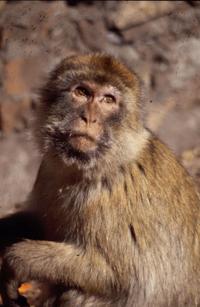
A Gibraltar macaque Photo by Robert D. Martin, Courtesy of The Field MuseumAfter decades of speculation, the origin of Gibraltar's famous Barbary macaques has been determined.
The only free-ranging monkeys in all of Europe, Gibraltar's 200 or so semi-wild macaques enjoy the run of the hillsides in this British territory – much to the delight of millions of tourists, as well as to the chagrin of some officials responsible for their management.
There were not always, however, this many macaques on Gibraltar, which serves as a gateway to the Mediterranean Sea. In 1942, after the population dwindled to almost nothing, British Prime Minister Winston Churchill ordered that their numbers be replenished due to a traditional belief that Britain would lose Gibraltar if the macaques there ever died out.
The clandestine move was taken to bolster Britain's morale during World War II. Ever since, scientists have wondered exactly where the macaques came from.
Now, an analysis of mitochondrial DNA from 280 individual samples reveals that the macaques on Gibraltar descended from founders taken from forest fragments in both Morocco and Algeria. The embargoed research will be published in the Early Edition of the Proceedings of the National Academy of Sciences (http://www.pnas.org/papbyrecent.shtml) on April 25, 2005. It will appear subsequently in PNAS' print version at a date yet to be determined.
"Our project was designed as a test case for conservation genetics," said Robert D. Martin, a primatologist, Field Museum Provost, and co-author of the study. "The Gibraltar colony of Barbary macaques provided an ideal example of genetic isolation of a small population, which is now a regular occurrence among wild primate populations because of forest fragmentation. To our surprise, we found a relatively high level of genetic variability in the Gibraltar macaques. This is now explained by our conclusion that the population was founded with individuals from two genetically distinct populations in Algeria and Morocco."
Key to study: mitochondrial DNA
In mammals, mitochondrial DNA is inherited exclusively from the female, so it can be analyzed to determine matrilineal origins. This is especially relevant with mammals, such as macaques, that practice female philopatry, a social system in which females remain in their birth groups while males migrate between groups.
The research first identified 24 different haplotypes in the Algerian and Moroccan colonies of macaques. Each mitochondrial haplotype is identified by means of a specific DNA sequence.
Since the Algerian and Moroccan haplotypes are clearly distinct, evidence of any given haplotype in the mitochondrial DNA of Gibraltar macaques would indicate that they descended from the geographical population with that haplotype. It had long been thought that the Gibraltar macaques were exclusively derived from founders imported from Morocco. In fact, both Algerian and Moroccan haplotypes were found among the Gibraltar macaques, indicating that the Gibraltar colony was founded by female macaques from both regions.
There are 19 species of macaques, which have proven to be remarkably adaptable. In fact, macaques are found in more climates and habitats than any other primate except, of course, humans.
The Barbary macaque, M. sylvanus, is the only species that lives naturally in Africa; all other species live in Asia. Some scientists believe the Barbary macaques were first brought to Gibraltar by the Moors, who occupied Spain between 711 and 1492. On the other hand, it's possible that the original Gibraltar macaques were a remnant of populations that had spread throughout Southern Europe during the Pliocene, up to 5.5 million years ago.
About 20 years ago, scientists estimated there were 20,000 Barbary macaques in Africa. Today, the wild population is only half that number, which led the World Conservation Union in 2002 to include the Barbary macaque as "vulnerable" on its Red List of Threatened Species.
The research also indicated that the initial split between two main subgroups of M. sylvanus occurred about 1.6 million years ago. The other co-authors of the study are Lara Modolo at the Anthropological Institute of the University of Zurich in Switzerland, who conducted all of the laboratory work on the DNA samples, and Walter Salzburger at the University of Konstanz in Germany.
"Our findings reveal that the Algerian and Moroccan populations are genetically very distinct and that there are major genetic differences even within Algeria," Modolo said. "Mixing of founders from Algeria and Morocco explains why the Gibraltar macaques have kept a surprisingly high level of genetic variability despite a long period of isolation.
"At the same time, the large degree of genetic difference seen between various wild populations tells us that we should be cautious about translocating animals from one area to another," she added. "This is just one of the lessons for conservation biology to be learned from this study."
Source : Field Museum
 Print Article
Print Article Mail to a Friend
Mail to a Friend
